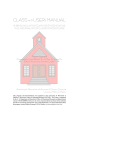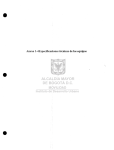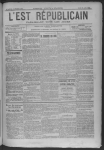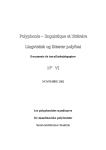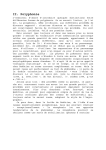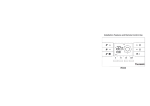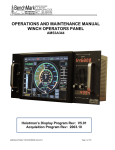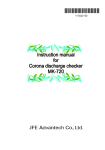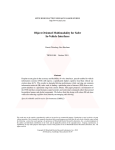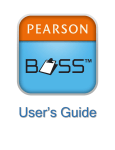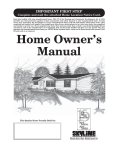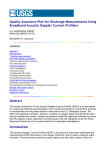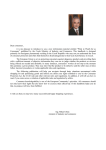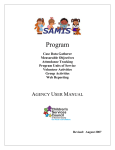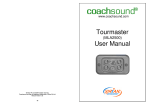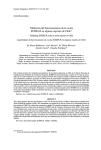Download CLASS User Manual - Center for Research on Dialogic Instruction
Transcript
CLASS 4.0 USER's MANUAL
A W IND O W S L APTO P -C O MPUTER S YSTEM FOR THE
I N -C LASS A NALYSIS O F C LASSROOM D ISCO URSE
Martin Nystrand
Programming by Yen-J u C hen & Yunpeng Pan
Editorial A ssistance by Samantha C aughlan
The N ational Research C enter on
English Learning & Achievement
U niversity at A lbany { U niversity of Wisconsin-M adison
CLASS 4.0 USER's MANUAL
A W IN D O W S L A PTO P -C O M PU T E R S Y S TE M F O R T H E
IN -C LA S S A N A LY S IS O F C LA S S R O O M D IS C O U R S E
17 September 2008
Martin Nystrand
Programming by Yen-J u C hen & Yunpeng Pan
Editorial A ssistance by Samantha C aughlan
This program and docum entation were prepared at the N ational Research Center on
English Learning and Achievem ent (CELA), that is operated by the University at Albany
in collaboration with the U niversity of Wisconsin at M adison’s Wisconsin Center for
Education Research (W CER ). The Center is supported by the U . S. D epartm ent of
Education's O ffice of Educational Research and Im provem ent (Award # R305A60005).
H ow ever, the views expressed herein are those of the author(s) and do not necessarily
represent the views of the departm ent. For m ore inform ation about the program , contact
M artin N ystrand, C ELA D irector: NYSTRAND @ SSC. WISC. EDU.
Classroom Discourse Is . . .
•
The language of learning (Courtney Cazden)
•
The ocean on which all else floats (James Britton)
Talking to Learn Is . . .
•
A struggle to organize . . . thoughts and feelings, to come up with words that . . .
shape an understanding (James Britton)
Table of Contents
Introduction
...........................................................1
Installation Procedure . . . . . . . . . . . . . . . . . . . . . . . . . . . . . . . . . . . . . . . . 4
§1. CLASS 4.0 Program Operation . . . . . . . . . . . . . . . . . . . . . . . . . . . . . 6
§1.1. Starting the Program . . . . . . . . . . . . . . . . . . . . . . . . . . . . . . . . 6
§1.2. When Class Session Starts . . . . . . . . . . . . . . . . . . . . . . . . . . . . 7
§1.4. Reviewing and Editing Questions . . . . . . . . . . . . . . . . . . . . . 16
§1.5. Matrices . . . . . . . . . . . . . . . . . . . . . . . . . . . . . . . . . . . . . . . . . . 17
§1.6. Ending a Class Session . . . . . . . . . . . . . . . . . . . . . . . . . . . . . . 17
§1.7. Datafile Names . . . . . . . . . . . . . . . . . . . . . . . . . . . . . . . . . . . . 18
§2. Rules for Classifying & Coding Classroom Discourse . . . . . . . . . . 20
§2.1. Discourse Episodes and Segments . . . . . . . . . . . . . . . . . . . . 20
§2.2. Approach to Question Coding . . . . . . . . . . . . . . . . . . . . . . . . 21
§2.3. Questions Not To Code . . . . . . . . . . . . . . . . . . . . . . . . . . . . . 22
§2.3.1. Rhetorical Questions . . . . . . . . . . . . . . . . . . . . . . . . . . 22
§2.3.2. Procedural Questions . . . . . . . . . . . . . . . . . . . . . . . . . . 22
§2.3.3. Discourse-Management Questions
. . . . . . . . . . . . . . . . . . . . . . . . . . . . . . . . . . . . . . . . . . . . . 22
§2.5. Authentic vs. Test Questions . . . . . . . . . . . . . . . . . . . . . . . . . 23
§2.5.1. Authentic Questions . . . . . . . . . . . . . . . . . . . . . . . . . . 23
§2.5.2. “W hat Else?” . . . . . . . . . . . . . . . . . . . . . . . . . . . . . . . . 23
§2.6. Uptake . . . . . . . . . . . . . . . . . . . . . . . . . . . . . . . . . . . . . . . . . . . 23
§2.6.1. Uptake by Ellipsis . . . . . . . . . . . . . . . . . . . . . . . . . . . . . 24
§2.6.2. Missing Uptake . . . . . . . . . . . . . . . . . . . . . . . . . . . . . . . 24
§2.6.3. Types of Uptake . . . . . . . . . . . . . . . . . . . . . . . . . . . . . . 25
§2.7. Cognitive Level . . . . . . . . . . . . . . . . . . . . . . . . . . . . . . . . . . . . 25
§2.7.1. Reporting vs. Thinking . . . . . . . . . . . . . . . . . . . . . . . . 25
§2.7.2. Generalization/Analysis . . . . . . . . . . . . . . . . . . . . . . . 26
§2.7.3. Factors Affecting Cognitive Level
. . . . . . . . . . . . . . . . . . . . . . . . . . . . . . . . . . . . . . . . . . . . . 27
§2.8. Coding Ambiguous Questions . . . . . . . . . . . . . . . . . . . . . . . . 28
§2.8.1. Preformulated Questions . . . . . . . . . . . . . . . . . . . . . . . 28
§2.8.2. Homework Questions . . . . . . . . . . . . . . . . . . . . . . . . . 29
§2.8.3. Redirected Questions . . . . . . . . . . . . . . . . . . . . . . . . . . 29
§2.9. Coding Responses to Questions . . . . . . . . . . . . . . . . . . . . . . 30
§2.9.2. Teacher Evaluation/Followup . . . . . . . . . . . . . . . . . . . 30
§2.9.3. Teacher Response to Student Questions . . . . . . . . . . . 30
§2.10. Classifying Instructional Activities . . . . . . . .
§2.10.1. Lecture . . . . . . . . . . . . . . . . . . . . . . . .
§2.10.2. Discussion . . . . . . . . . . . . . . . . . . . . .
§2.10.3. Student Presentation: Quick
Careful . . . . . . . . . . . . . . . . . . . . . . . . . . .
§2.10.4. Reading Aloud . . . . . . . . . . . . . . . . . .
§2.10.5. Role Play or Simulation . . . . . . . . . . . . . . . . . . . . . . .
§2.10.6. Game . . . . . . . . . . . . . . . . . . . . . . . . . . . . . . . . . . . . .
§2.10.7. Class Interruption . . . . . . . . . . . . . . . . . . . . . . . . . . .
§2.10.8. Seatwork . . . . . . . . . . . . . . . . . . . . . . . . . . . . . . . . . . .
§2.10.8.1. Writing Without Composing: . . . . . . . . . . . . .
§2.10.8.2. Composing . . . . . . . . . . . . . . . . . . . . . . . . . . . .
§2.10.9. Small Group Work . . . . . . . . . . . . . . . . . . . . . . . . . . .
§2.10.10. Offtask . . . . . . . . . . . . . . . . . . . . . . . . . . . . . . . . . . .
§2.10.11. Discipline . . . . . . . . . . . . . . . . . . . . . . . . . . . . . . . . .
§2.10.12. Shifting Numbers of Students . . . . . . . . . . . . . . . . .
§2.10.13. Ambiguous Activities . . . . . . . . . . . . . . . . . . . . . . . .
§2.11. Matrices . . . . . . . . . . . . . . . . . . . . . . . . . . . . . . . . . . . . . . . . .
§2.11.1. Activities Not to Code . . . . . . . . . . . . . . . . . . . . . . . .
§2.11.2. Types of Materials . . . . . . . . . . . . . . . . . . . . . . . . . . .
§2.11.3. Types of Writing . . . . . . . . . . . . . . . . . . . . . . . . . . . . .
§2.11.4. Types of Literature . . . . . . . . . . . . . . . . . . . . . . . . . . .
§3. Editing Data . . . . . . . . . . . . . . . . . . . . . . . . . . . . . . . . . . . . . . . . . . .
§3.1. Basic Editing Functions . . . . . . . . . . . . . . . . . . . . . . . . . . . . .
§3.1.1. Merging Episodes and Segments . . . . . . . . . . . . . . . . .
§3.1.2. Splitting Episodes and Segments . . . . . . . . . . . . . . . . .
§3.1.3. Rearranging Segments . . . . . . . . . . . . . . . . . . . . . . . . .
§3.2. Proofreading and Cleaning Data . . . . . . . . . . . . . . . . . . . . . .
§3.3. Time Summary . . . . . . . . . . . . . . . . . . . . . . . . . . . . . . . . . . . .
§3.4. Calculate Statistics . . . . . . . . . . . . . . . . . . . . . . . . . . . . . . . . . .
§3.5. Question Plot . . . . . . . . . . . . . . . . . . . . . . . . . . . . . . . . . . . . .
§3.6. CLASS 4.0 Question Editor . . . . . . . . . . . . . . . . . . . . . . . . . .
§3.7. Segment Editor . . . . . . . . . . . . . . . . . . . . . . . . . . . . . . . . . . . .
§4. Interpreting CLASS Files . . . . . . . . . . . . . . . . . . . . . . . . . . . . . . . . .
References . . . . . . . . . . . . . . . . . . . . . . . . . . . . . . . . . . . . . . . . . . . . . . . .
Annotated EPS file . . . . . . . . . . . . . . . . . . . . . . . . . . . . . . . . . . . . . . . . . .
Index . . . . . . . . . . . . . . . . . . . . . . . . . . . . . . . . . . . . . . . . . . . . . . . . . . . .
ii
31
31
31
vs
32
32
32
32
32
32
33
33
33
34
34
34
34
35
35
35
37
38
42
43
44
44
44
45
45
46
48
50
51
54
60
62
67
Introduction
4.0 is a Windows laptop-computer program for the in-class
analysis of classroom discourse. The unit of analysis in this
program is the question, and to operate C LASS 4.0, the classroom
obser ver types in and codes each nonprocedural question that
teachers and their students ask during the course of a class
period. Procedural questions, e.g., questions about pages to be
read as homework, are not included in this analysis since they are
peripheral to instruction and learning.
Questions, of course, presume answers, and question-answer
exchanges dominate classroom interactions in English Language
Arts instruction. Hence, for purposes of analysis, the questions
teachers and their students ask during a class period effectively
index the entire discussion, and we may build profiles of
instruction and study classroom discourse by focusing on the
questions.
In using CLASS 4.0, the observer is prompted to code each
question for (a) source (who asks the question: teacher or
student), (b) response (whether there was a response), (c)
authenticity (authentic questions are questions for which the
teacher has not prespecified an answer), (d) uptake (uptake
occurs when a teacher incorporates a previous student answer
in a subsequent question), and (e) cognitive level (report or high
level: generalization/analysis).
Unlike previous versions of CLASS , CLASS 4.0 codes responses
to questions for (a) respondent’s identity, (b) extent of elaboration, (c) audience for the response (teacher or class), and (d)
relation of response to other responses.
Because of the importance of student questions (Nystrand,
Wu, Gamoran, Zeiser, & Long, D. [2001]), CLASS 4.0 also
prompts the observer to code the teacher’s response to student
questions,
checking whether the teacher uses the question to open up
discussion or manages it in such a way as to table it.
During seatwork, lecture, reading aloud, small group work,
and question-answer activities, CLASS 4.0 prompts the observer
CLA SS
Introduction
3
periodically to indicate the number of students who are obviously offtask, plus any appropriate adjustments in the number of
students in the class (in case any have recently entered or left the
classroom). The program also elicits miscellaneous holistic
assessments of instruction and curriculum after each observation.
W hen data collection is completed, the observer can use the
program to proofread, edit, and revise the file for incomplete
and inappropriate codings and compute basic statistics for each
episode and class.
CLASS 4.0 is premised on a view of instruction not as what
teachers provide or do to students but rather as what teachers
and students collaboratively negotiate.
High-quality classroom
discourse is characterized by substantive reciprocity between
teachers and their students.
In such instruction, students and
not just teachers have a lot of input into the business of the
classroom and hence what is learned.
CLASS 4.0 provides a
number of measures designed to assess the quality of interaction
between teachers and their students. A fuller discussion of this
view of instruction as discourse is presented in Nystrand (1997),
Applebee (1996), and Langer (1995).
The linkage of hum an to hum an is, in the final analysis, the groundwork of all
ethics as a reflection on the legitimacy of the presence of others. H . R. M aturana
& F. J. Varela
The bottom line for instruction is that the quality of student learning is closely
linked to the quality of classroom talk. M artin N ystrand
3
Installation Procedure
Installation of CLASS 4.0 involves five files available on both disk
and web. Begin by creating a special subdirectory on your hard
drive for the five installation files, e.g., C :\ PRO G RA M S \ CLASS . The
program can be installed from a CD installation disk.
Using the installation CD , run SET U P .EX E . Be sure you have no
other programs running when you do this. If you are warned
that you are about to write over any existing *.dll files, be sure to
K E E P T H E F IL E S YO U 'V E A L R E A DY G O T--D O N 'T
W RITE OVER ANYTHING.
You can "ignore" any other
warnings.
4
Reading and w riting experiences are best supported through conversations in
w hich students’ grow ing and changing understandings guide “the questions w e
ask and the w ays w e teach.” Judith Langer
§1. CLASS 4.0 Program Operation
CL A SS
4.0
§1.1. Starting the Program
To start the program, turn the computer on, and click on the
Class 4.0 desktop icon.
The program will load, and after the
CELA logo, you will note the date and time. To start collecting
data, click on the default: NEW OBSERVATION (the other choices, for
editing data, are explained below).
Next, you will be asked to enter basic information: your
initials, plus school, class, observation numbers, and the number
of students present.
6
CLASS 4.0 PROGRAM OPERATION
7
W hen you enter school, class,
and obser vation num be rs, the
program checks to make sure that
you have not already set up a file
for the class observation you indicate.
It checks both main (.EPS )
files and backup (.BA K ) files, and
warns you in the event that either
already exists.
If you enter nothing when so
prompted, the display will flash at
the offending (non)entry, and the
program will not proceed till you oblige it. You should enter all
preliminary information before class begins.
If you make any
mistakes, click RESET and start over.
§1.2. When Class Session Starts
Click START when the bell rings. You will be prompted to enter
an initial description of the episode (typically, you will type
“Getting started” for the first episode).
Don’t worry if you’re
not sure exactly what’s going on when you first describe the
episode; you will have plenty of opportunities to revise and
expand your description. Indeed, you will want to make changes
as each episode unfolds.
W hen you type in the episode description, be sure to press
ENTER 5 , but do NOT–repeat N OT!--ever include either a Hard
Return (carriage return) or a colon in an episode description (the
program erroneously misreads these as program instructions).
You will then be confronted with the Class Activity Menu. In
the pper right hand corner of the screen, note episode and
segment numbers and episode and segment times, plus actual
current time.
8
CLASS 4.0 USER's MANUAL
On this screen, you will need to click the appropriate activity,
indicated here as “Procedures.”
We define an episode as any coherent classroom activity
centering around a particular purpose or topic. A new episode
starts when the teacher addresses a new purpose or topic.
Sometimes episodes will consist of two or more activities. For
example, in addressing a particular objective, the teacher may
initiate a question-and-answer session which is then interrupted
by periodic, brief lectures, and culminates with a homework
assignment. When something like this happens, we say that the
episode is divided into segments.
A segment is any coherent
part of an episode which differs from other activities constituting an episode. It may help to think of an episode as a “chapter”
and a segment as a “paragraph” within a chapter.
CLASS 4.0 PROGRAM OPERATION
9
H OT BU TTO N S
The initial episode and segment numbers will both be 1 when
you start, of course, and the segment number will advance each
time you indicate a new type of activity within the episode.
W hen the first episode/segment ends, you will need to click EPISODE
or
SEGMENT to mark the end of the current activity episode or
segment and the start of a new one.
If you select Q /A , you will immediately be switched to the
QUESTION-ENTRY AND CODING mode (see p. 12).
Menu functions available include:
CLOCK resets the clock. If you are late in
recognizing the start of an episode or
episode segment, you can lengthen
the segment by resetting the clock.
W hen you click on C LOCK , a time bar
will be displayed: To lengthen the segment, move the marker on the bar to
the right; to shorten the segment, move
the marker to the left.
The scale registers the change; the
number at the right is the maximum number of seconds you
can change the time.
EPISODE
initiates a new episode.
This option ends the current
episode and returns you to the menu to start a new episode.
Upon clicking EPISODE , you will first be prompted, as necessary, to enter the number of students offtask, and then you
will return to the activity menu.
SEGMENT
initiates a new segment.
Use this option when the
teacher continues with the same topic or objective but
switches from activities. Upon clicking SEGMENT , you will first
be prompted, as necessary, to enter the number of students
offtask, and then you will returned to the activity menu.
Select the appropriate activity (do not type in a description
this time), and answer “Y” to the prompt “< ACTIVITY >
(Y/N)” to confirm your selection.
10
CLASS 4.0 USER's MANUAL
and PROOF enable in-class data [question] editing. If you
are observing some activity other than question/answer, e.g.,
lecture or seatwork, you can press PROOF to find questions
that you may not have had time to complete, though please
note that the routine will work only after the first Q/A
segment.
The program automatically searches for missing or
incomplete codes.
REVIEW
allows not only corrections of codings, insertions and
deletions of questions, etc., but also rewording of questions
and expansions of episode descriptions.
REVIEW
and PROOF
give you access to data from both current and previous
episodes and segments, including questions and episode
descriptions from previous episodes or segments.
If you choose to proof questions during seatwork and
lecture, the program will continue to monitor OFFTASK and
will prompt you regularly every two minutes. When prompted, simply click on the blinking OFFTASK button, and enter your
estimates; you do not have to stop proofing to do this. To
return to the menu you left to do proofing, simply press
RETURN ; the program will know where you left off.
EP. TO SG . and SG . TO EP. allow predesignating a new episode as an
additional segment in the previous episode, or a new segment
at the start of a new episode. Occasionally you may realize
that the new episode you just initiated is really just a segment
EP. TO SG .
of the previous episode you thought was over.
allows you to deal with this problem.
MATRICES
shifts the program to a set of holistic assessment
instruments. See §1.5.
END CLASS See §1.6.
FIELDNOTE , present in the upper right area of the screen, allows
you to make notes at any time during the observation concerning items of interest not handled by CLASS .
FIELDNOTE is
for:
REVIEW
•
Anomalies: When something important comes
can't be handled by the program, make a fieldnote.
up
that
CLASS 4.0 PROGRAM OPERATION
•
11
Uncertainties: When you are unsure of how to code
something, make a fieldnote so you can reconsider it
when you rewatch the video and edit the EPS file.
W henever the program or the class session unfolds in
surprising ways, make a fieldnote.
Here’s an example from an observer:
FIELDNOTE:
“I didn’t know how to handle the "organization" values for
group presentations and seatwork. At what point dowe es the pointer move
from T to S? For example, in one lesson, a teacher gave the class a prompt to
write about whether and how they used what they were learning in this class in
other classes, and if they weren't using it, why not? They wrote for about fifteen
minutes, and she read them aloud. Although they all answered the prompt,
they were quite individual. Is this T organization, or S?”
This question about the student organization of group presentations and seatwork is a perfect example of fieldnote use.
CLASS automatically time stamps all fieldnotes, but the times
are recorded in the BAK file, not the NTE file. This awkwardness is due to the fact that CLASS makes it possible to revise
each fieldnote as the class session unfolds; hence, a given
fieldnote can have multiple time stamps. This is best handled in
the BAK files, where each and every coding & revision is
recorded and time stamped as they occur. If time is important,
it may be necessary for you to retrieve the fieldnote from the
BAK file. Of course, youcan always type in the time or episode
& segment numbers into the note itself.
By taking students seriously, teachers elicit the best from students by expecting
the m ost. O pening D ialogue, p. 92.
12
CLASS 4.0 USER's MANUAL
§1.3. Entering and Coding Questions
In the Q /A screen, the cursor will prompt you to Enter 1
(Question #1). T he program will not let you continue if you fail
to type in a question and press EN TER . In coding each question,
the options for each variable are shown in parentheses. One of
these options is starred. This option is the default, and if you
merely press E N TER , the program will record this value, and
prompt you for the next value. (The defaults are SO URCE :
Teacher; RESPO N SE : Yes; AUTH EN TICITY : No; U PTA KE : No; CO G N IT IV E LEV EL : Report. For full explanation of coding rules for
questions, see §2. Rules for Classifying and Coding Classroom
Discourse.)
In QU ESTIO N - EN TRY A ND CO D IN G M O D E , several hot buttons are
available to you here (we explain only the functions that are
new):
, available only during coding, codes normal questions
appropriate default values:
source: SO URCE : Teacher;
RESPO N SE : Yes; AUTHEN TICITY : No; U PTA KE : No; CO G N IIV E LEVEL :
Report; multiple RESPO N SE : No; unelaborated.
You may find it more efficient to code questions
holistically by first deciding whether or not they are normal
than it is to proceed atom istically by coding each variable as
NORMAL
with
CLASS 4.0 PROGRAM OPERATION
13
you are prompted. If the question is normal, you can click
NORMAL , and be onto the next question; even if it is not
normal, you can click NORMAL and then quickly determine the
ways in which it is not normal, e.g., it is authentic and there is
uptake, in which case you can quickly code these two variables and accept the other defaults and, without paying
attention to the other, normal values, move on.
DITTO , available after coding the first question, duplicates the
previous question and the codings for that question.
It
should be used when a teacher repeats a question (e.g., to
another student).
If you type in a question and then click
DITTO , the codings for the previous question but not the actual
previous question will be duplicated.
N EXT Q , [also <Ctrl-N>], available only during question coding,
moves on instantly to the prompt for the next question. Use
it when you do not have time to complete the coding for any
given question.
The program will automatically insert
highlighted asterisks for each uncoded variable; you will see
these when you enter REVIEW , PROOF , or EDIT mode. Hence,
the program keeps track and will remind you of exactly which
items need your attention.
If you’re going really fast and
don’t have time to click on NEXT Q , you can execute the same
function by pressing <Ctrl-N>.
SEGMENT
switches from question/answer to some other activity,
such as a lecture or procedures. After asking if you mean it
(“Start new segment? YES NO ), you will be prompted to enter
the number of stu dents offtask,
and then you will be
returned to the activity menu.
Click on the appropriate
activity (do not type in a description this time). If you entered
Q/A using the hot button on the class activity screen, there
will also be a button next to SEGMENT with the name of the
activity you left to code questions. This enables you to return
to that activity immediately if the class does.
SCRAP drops the current question and clears the screen.
Use it
when you have started inputting a question and realize that it's
not really a question or that it's really a procedural question–in
short, when you want to scrap it.
14
CLASS 4.0 USER's MANUAL
You may also scrap a question after the fact by pressing DROP
in REVIEW mode in response to any question.
LAST ,
available after coding the first question, deletes the
previous question. It is useful if, after coding a question, you
decide to drop the question, for example, after realizing that
the question was procedural or rhetorical, i.e., not a question
to be coded.
CLOCK resets the clock (see instructions, p. 9).
END CLASS See §1.6.
OFFTASK
periodically will become active during some
activities: you will see it
blinking in the window in
the upper right of the
screen (right under Current Time) is the offtask
prompt. When this happens, or as soon as you’re
able, click on the flashing
alert; this will open a new
w indow for recording
your estimate of the number of students who have been
obviously offtask during about the previous minute.
To do
this, you will need to keep a running sense of activity in the
classroom as it happens. If no students were offtask and the
number of students in class has remained constant, press
“OK.”
Otherwise, after you enter the number of students
offtask, CLASS will also prompt you to verify or revise, as
needed, the number of students in attendance, noting if any
students have entered or left the classroom since you last
counted them.
Sometimes, CLASS will prompt you make
offtask estimates when you’re struggling to keep up with a
blizzard of questions. If this happens, you can either ignore
the blinking prompt until you can handle it, or you can raise
the offtask window and simply press the Skip button, and no
data will be recorded. T he next scheduled offtask prompt will
offer you “Skip” as the default.
CLASS 4.0 PROGRAM OPERATION
15
If you ignore the Offtask Prompt, you need not worry
about forgetting it since it will never forget you–it will blink
and blink and blink until you take care of. And if you let it go
too long, you’ll get another alert more quickly the next time
since it is programmed to blink every two minutes during
lecture and every 5 minutes during Q/A regardless of how
quickly you respond to it.
Students are to be counted offtask in terms of the
teachers’ expectations. In some classes, teachers expect every
student to pay attention during a filmstrip whereas in other
classes students may either watch the filmstrip or do homework; students doing homework should be counted as offtask
in the first class but not in the second.
The key word here is “obvious”: To count as offtask,
students must clearly be reading comics, passing notes,
dancing in the aisles,
getting into trouble, etc.; don’t try to
make any inferences about window gazing or mind wandering. Just count students offtask if it’s obvious.
The number of students recorded as offtask should be the
average number of students offtask at any given moment in the minute prior to the
prompt.
You will be prompted to estimate the number of
students offtask every 5 minutes during Question-Answer
sessions and
every 2 minutes during seatwork, small group
work, reading aloud, and lectures.
For a question-answer session that lasts less than five
minutes, you will be prompted to give offtask estimates upon
exiting the Q /A routine. In the Q/A routine, the prompt
occurs as a flashing * OFFTASK * immediately under the
time indicators. When prompted, press the OFFTASK button,
and respond to the prompts.
16
CLASS 4.0 USER's MANUAL
Q uestion-answer exchanges, which dom inate instruction in Am erican English
Language Arts instruction, occupied 30% of class tim e in the eighth-grade
classes Nystrand and his colleagues studied and 42% of the ninth-grade classes.
They play a key role in both accom m odating and excluding student voices in the
public, authoritative discourse of the classroom, and they are the central
instructional m echanism in Am erican classroom s for assigning epistem ic roles
to students. As such, they significantly regulate the extent to w hich teacherstudent interaction can be dialogic. O pening D ialogue, p. 36
§1.4. Reviewing and Editing Questions
You may review and edit any questions or codings by clicking on
REVIEW .
In the window to the right, you will see a display of the
question you were last coding in the context of several previous
questions.
If you want to review questions from a different
episode, select the episode in the top left window. Click on the
question you want to revise. The question highlighted will also
be displayed in the window to the left with all its coded values
below. You can revise both the question and the values.
CLASS 4.0 PROGRAM OPERATION
17
In this mode, several functions are available:
automatically codes any question with all the default
values.
DITTO duplicates either the previous question or the codings for
the previous question or both.
Click on either CODING or
Q & CODE .
DROP
deletes the current question.
The question is eliminated
from the set, and each of the subsequent questions is renumbered.
I NSERT
enables the insertion of a new question, either after
(Insert A) or before (Insert B) the highlighted question.
RETURN exits review mode and returns to your previous location.
R #Q ’ S will renumber all questions in consecutive order once you
are done deleting and inserting questions.
NORMAL
§1.5. Matrices
MATRICES
shifts the program to a set of holistic assessment
instruments implemented in four scales.
You m ay be able to
start completing them during class, particularly when the last
activity in the class is seatwork. When you move to the matrices,
you will be able to return to the other components of the
program. For definitions of all terms, see §2.11.
§1.6. Ending a Class Session
Clicking END CLASS marks the end of the class observation. You
will be asked to verify (Yes/No) if you want to END. You will
also be given a chance to access the matrices before quitting the
program (more final than marking the end of class). If you did
not describe the episode at the start, you will be asked to do so
now in a few words.
You may also be prompted to indicate
whether or not the episode was mainly/entirely a review of
previously learned material (Yes/No).
18
CLASS 4.0 USER's MANUAL
§1.7. Datafile Names
EPS , SUR , BAK ,
&
NTE
Files.
Data are saved under
a file name that is a compilation of School-Class-Observation
numbers, plus the extension eps (for episode data).
For
example, data for School 23-class 42-Observation 4 will be saved
as 23-32-4.EPS . In addition, class creates a separate file for
matrices data (*.SU R files), and backup (*.BA K ) file. The backup
is compiled sequentially as each question is typed, entered, and
coded. Each entered item is time stamped in the file itself. If
for any reason you are unable to finish a class session using the
program (e.g., you r un out of battery power), this backup file will
preserve whatever data you created prior to the problem.
Finally, C L A S S 4.0 allows observers to compile free form
fieldnotes. These will be saved in *.NTE files.
The word is a two-sided act. It is determ ined equally by whose word it is and for
whom it is meant. As word, it is precisely the product of the reciprocal
relationship between speaker and listener, addresser and addressee . . . . I give
m yself verbal shape from another’s point of view, ultim ately from the point of
view of the com m unity to w hich I belong. A w ord is a bridge thrown between
m yself and another . . . . A w ord is territory shared by both addresser and
addressee. Valentin Vološinov
The forms of discourse encountered in ... formal schooling provide the
underlying fram ework within w hich concept developm ent occurs. Jam es W ertsch
§2. Rules for Classifying & Coding
Classroom Discourse
24 O CTO BER 2001
§2.1. Discourse Episodes and Segments
An episode is a coherent classroom activity centering around a
particular purpose or topic.
A new episode starts when the
teacher addresses a new purpose or topic. High school lessons
typically begin and end with procedural episodes “Getting
started” and “Preparing to leave.”
Between these episodes, we
typically find one or more instructional episodes, which often
consist of two or more activities.
For example, in teaching a
lesson on Roll of Thunder, Hear My Cry, a teacher may begin by
reviewing the previous night’s reading assignment in a questionand-answer session, which develops into an open discussion or
leads to smallgroup work, which culminates in in-class writing as
students write their reactions to the exchange of views during
discussion; the teacher views this writing as a head start of that
night’s homework assignment, which is to read the next chapter.
CLASS treats sequences of activities like this as a series of
segm ents comprising an instructional episode.
The episodic
structure for the lesson just mentioned is:
Episode 1: Getting started
Episode 2: Roll of Thunder, Hear My Cry
Segm ent 1: Q/A
Segm ent 2: Discussion
Segm ent 3: Seatwork/m onitoring
Episode 3: Preparing to leave
20
RULES OF CODING
21
An activity is defined by how it develops or is realized. If a
teacher’s planned review turns into a discussion, it is to be coded
as a Q/A segment followed by a discussion segment, even if the
teacher planned only a review.
Similarly, if students are doing
silent reading start writing answers to hom ework questions
about the reading, it is to be coded as a silent reading segment
followed by a seatwork segment. Two rules:
•
•
Activities are defined by how they are enacted.
If some students are engaged in one activity, e.g., silent
reading, and others are doing something else, answering
homework questions, code the activity which most of the
students are doing.
§2.2. Approach to Question Coding
CLASS question coding treats questions as sites of
interaction.
As Heritage & Roth (1995) and Schegloff (1984)
contend, the character of any unit of discourse and related
interaction is a function of the participants’ understanding.
Following this principle, you are to code not questions per se
but rather the participants’ understandings of their interactions
as manifest by their discourse moves. To judge the authenticity
of a question, for example, requires that you take your cues not
only from how students answered the questions, but also how
the teacher responded to the students’ answers.
As with
authenticity, cognitive level is to be coded according to the level
of cognitive functioning the question elicited, not the question
by itself. In all cases, code not the questions directly but rather
the character of social interaction involving, valorized, and
elicited by the questions.
§2.3. Questions Not To Code
§2.3.1. Rhetorical Questions. Be alert to rhetorical questions.
They are not to be rated (not even recorded).
22
CLASS 4.0 USER's MANUAL
§2.3.2. Procedural Questions.
Questions like "Does that
answer your question?" and "Do you have any questions?" are
procedural, not substantive and should not be included in your
list of coded questions.
§2.3.3. Discourse-Management Questions. Questions like
(a) "W hat?", "Did we talk about that?", or "W here are we [in the text]?", which
manage classroom discourse, and (b) "Do you remember our discussion
from yesterday?", which initiate discourse topics, should not be
coded.
§2.4. Aborted and Repaired Questions
A question-and-answer sequence is a negotiation of sorts.
In
asking a question, a conversant in effect enters (or sustains) a
negotiation with conversants, and the question posed must work
in terms of the knowledge, experience, and expectations of the
other conversants, i.e., it must initiate or sustain a shared balance
of discourse (Nystrand, 1986).
If te a c h e r s a s k q u e s t io n s th a t
elicit no answer, this is an aborted question; click ‘N’ (No) when
prompted for RESPONSE (Y*/N: the asterisk indicates that Y
is the default; simply pressing < E NTE R >). Note that an aborted
question is different from a repaired question, which is a question
the teacher asks and, without giving students a chance to answer,
revises. When someone repairs a question, you need only record
the final version of the question.
The proportion of teacher questions that fails to elicit an
answer is an index of the extent to which the teacher incorrectly
anticipates the capabilities and knowledge of the class.
If the
teacher asks too many questions that students are unable to
answer or don’t know how to answer, it means that the teacher
has misjudged the students in some fundamental way; the
question indexes a mismatch.
RULES OF CODING
23
§2.5. Authentic vs. Test Questions
Learning is often built on surprises. Robert G undlach
§2.5.1. Authentic Questions
are questions whose answers
are not prespecified by the teacher. By contrast, an inauthentic
question, sometimes called a test question, allows students no
control over the flow of the discussion, and an authentic
question allows the student substantial input, if not control over,
the flow of the discussion.
§2.5.2. “What Else?” Code the question "W hat else?" as:
•
•
Inauthentic (test) when it is used for negative evaluation, i.e.,
when a student gives a wrong answer and the teacher
continues to look for the correct one by saying, "W hat else?";
or
Authentic when used during brainstorming, i.e., when any
answer is satisfactory.
§2.6. Uptake
Uptake is the speaker’s incorporation of a previous answer into
a subsequent question (Collins, 1982). It is often marked by the
use of pronouns:
C
C
C
How did it work?
W hat causes this?
W hat city grew out of this?
In such questions, the pronoun (technically a deictic reference)
refers to a previous response.
To qualify as uptake, a question must incorporate a previous
answer, not a previous question. Normally, this incorporation of a
24
CLASS 4.0 USER's MANUAL
previous answer will involve actual quoting.
repeated do not qualify as uptake.
Less obvious deictics include:
Questions that are
th e n : e.g., "And then what happened?" Here then means "after that,"
i.e., "after what you just said."
s o : e.g., "So which value was given to them?" Here so means "Given
that," i.e., "Given what you just said, which value was given to them?"
m a y b e : e.g., "Maybe. W hat do you think?" where maybe should be
read maybe so.
t h o u g h : e.g., "Per item though?" where teacher follows up a
student response to get a more specific answer (previous
question was "W hich has higher overhead?"): though here means
"despite or beyond what you said."
§2.6.1. Uptake by Ellipsis.
Uptake may be characterized by
ellipsis. For example, if, when a teacher asks a question and a
student answers, the teacher then asks "W hy?", the "W hy?" is to be
scored positive for uptake; "W hy?" incorporates the previous
student answer by ellipsis. "Because . . .?” as a follow up question
works the same way.
§2.6.2. Missing Uptake.
In the following sequence, there is
no uptake:
Teacher question:
Student response:
Teacher question:
W hat’s the first x?
...
W hat’s the second x?
There is no uptake here because the teacher
incorporate a student’s answer into a subsequent question.
§2.6.3. Types of Uptake.
does
not
Uptake will either be faux (test)
uptake or authentic uptake.
•
Authentic uptake: Teacher
about a student response.
asks
an
unprescripted
question
RULES OF CODING
•
25
Test (faux) uptake:
(a) Teacher incorporates previous answer into an ongoing
script. E.g.,
Teacher: W hat’s the subject of the sentence?
Student: “Rabbit”
Teacher: And the rabbit did what?
In this exchange, the teacher follows up on the student’s
a n sw e r (“ r a b b it” ), b u t th e a n sw e r w a s e ntir e ly
predictable.
(b) Teacher follows up a student answer to check (test) the
student’s understanding
§2.7. Cognitive Level
§2.7.1. Reporting vs. Thinking.
We distinguish two levels of
cognition:
R* Recitations and reports: What happened? Don’t correspond
to screen prompts (default)
H High-level generalization or analysis, i.e., thinking:
What
happens? and W hy?
As a general rule of thumb, lower-order questions (i.e., questions
eliciting reports) result in answers that are known information
w h e re a s h ig h e r- o r d e r q u e s tio n s ( i.e., q u e s tio n s elic itin g
generalizations, analyses, or speculations) result in answers that
are new information.
Like authenticity, the cognitive level of questions cannot be
judged altogether from words alone.
In judging cognitive level,
code the level of cognitive functioning that the question seeks
to elicit, not the question by itself or its linguistic structure.
Cognitive functioning is high to the extent that "the question
cannot be answered through the routine application of prior
26
CLASS 4.0 USER's MANUAL
knowledge" (Newmann, 1988).
In Polanyi’s (1962) terms, lowlevel cognitive functioning is a routine performance whereas
high-level cognitive functioning is a heuristic act. Hence, though
a why-question will ostensibly elicit an analysis, it will elicit a
report if the teacher’s focus is the recitation of a textbook's
analysis rather than the class’s reflection,
In such a situation,
“W hy?” really means, “According to your text, why did it
happen this way? Do you remember?”
§2.7.2. Generalization/Analysis.
Generalization is the
derivation or induction of a general conception or principle
from particulars, typically in response to an open-ended
question.
Analysis is the determination of the nature and
relationship r of parts in a whole entailing two or more stipulated
particulars or concepts a, b.
In analysis the teacher typically
stipulates terms for consideration (e.g., "Given what we’ve just said, given
a and b, etc., what’s the author’s point?") whereas in generalization the
teacher does not stipulate terms for consideration; the students
do (e.g., "W hat’s the point?").
Examples of generalization: W hat happens when you get to the next
stanza? W ho are these people? W hat do you think is the message? W hat does it mean
to be in shackles? W hat does a tornado do? W hat’s the author saying here? W hat’s
it all about? Contrastive example of generalization and analysis:
T EACH ER :
S TU DEN T :
T EACH ER :
W hat did Robert Fulton do? W hat was the result? How did
his success affect river travel? W hat’s a problem that some rivers
have?
...
So how did Fulton’s success affect river travel?
In the first question, which is a multiply repaired question, the
teacher is working to stipulate the terms of an analysis he wants
students to do. The question, "W hat’s a problem some rivers have?" is
meant to elicit a generalization in preparation for a particular
analysis these questions are driving towards: "So how did
Fulton’s success affect river travel?"
RULES OF CODING
27
§2.7.3. Factors Affecting Cognitive Level.
The cognitive
level of any question is affected by: (a) the knowledgeability of
th e pe rson answering the q uestion, (b ) n atu r e o f th e
instructional activity, and (c) the source of information required
by the question.
(a) Knowledgeability of the person answering of the question.
Questions are to be coded as reports when their answers elicit a
routine cognitive operation. But note that "routine" varies
depending on what the person answering the question knows: The
very same question that elicits an analysis from one person may
well elicit a report from another, more knowledgeable individual.
This distinction is especially germane to teacher or student
questions.
For example, "How did the French regain control of
Canada?" may well elicit an analysis from students (assuming, of
course, that they have to figure out the answer and not merely
recite their textbook account on the point), but it will elicit a report
if a student asks the teacher, who already knows the answer. Of
course, teachers may not have the answers to all student questions
at their fingertips, and if the teacher clearly thinks about a
challenging student question, as indicated by a pregnant pause, for
example, the question is to be considered as an instance of
generalization or analysis.
Nonetheless, most student questions
addressed to teachers will elicit reports. In some low-ability classes,
spelling or even pronouncing new and difficult words will require
analysis whereas in other classes, where students have already
mastered the pronunciations and spellings of the same words, their
spelling is a mere, routine report.
(b) Nature of the instructional activity. When whole-class instruction is
devoted to review, the normal expectation for the cognitive level
of the questions is report, even if the questions have the linguistic
form of higher level questions.
Sometimes, of course, you may
encounter teachers who use review as a basis for analysis and
reflection, so take this situation into account in your coding.
(c) Source of information required by the question. We define "prior
knowledge" as "prior to the previous night’s homework." Hence,
if a teacher asks students about the previous night’s reading, the
question will normally elicit a report.
28
CLASS 4.0 USER's MANUAL
§2.8. Coding Ambiguous Questions
§2.8.1. Preformulated Questions
(e.g., "Do you think that’s
important?"). In judging cognitive level of preformulated questions,
disregard the preformulator ("Do you think. . ."), and code the
remainder of the question ("Is it important?"), i.e., code only the
nuclear utterance (cf. French and Maclure, 1981).
Superficially
a question such as "Do you think that’s important?" elicits a record (i.e.,
what the student is thinking now), but if the real purpose of the
question is to elicit a higher cognitive operation (an analysis of
what is important), it should be so coded. Hence:
"Do you think that’s important?"="Is that important?"= AN ALYSIS
"Do you know what a catechism is?"="W hat is a catechism?"= RE PO RT
"Do you understand why #11 is a ‘b’?"="W hy is #11 a ‘b?’= AN ALYSIS
"W hat do I mean by ‘transition’?"="W hat’s a transition?"= RE PO RT or
AN ALYSIS , depending on context student to report. When in
doubt about cognitive level, always ask what mental operation the
question is eliciting (not the literal meaning of the question).
Hence, "Should I do anything more with it?" should be coded as
"W hat more should I do with it?"
§2.8.2. Homework Questions.
Sometimes teachers will ask
questions about things students have already completed or
considered, e.g., homework.
If, in answering these questions,
students actually consult their homework, the question will elicit
a report, since the students are reporting on what they have
already done.
If the students do not actually consult their
homework, however, the questions should probably be coded as
if they had been asked the first time, i.e., analysis/generalization.
When teachers ask questions about what students are thinking (and not just to
see if they have done their homework), and when they ask them questions about
their previous answers, they promote fundamental expectations for learning by
seriously treating students as thinkers, i.e., by indicating that what students think
is important and worth examining (Martin Nystrand)
RULES OF CODING
29
§2.8.3. Redirected Questions.
Whenever a teacher redirects
a question to another member of the class, code the new
question with the same values as the original question; use DITTO .
This includes uptake, authenticity, and cognitive level.
For
example:
Eugene, can you tell me a bit about it?
Mike?
T A Report
T A Report
§2.9. Coding Responses to Questions
M eaning is realized only in the process of active, responsive understanding.... Only the
current of verbal intercourse endows a word with the light of meaning. Valentin Vološinov
§2.9.1. Principal Codings
•
•
Relation to other responses. One part of multiple response
(y/n). When teachers encourage or allow multiple responses
to a single question without repeating the question, it can
indicate a transition to dialogic interaction in the class.
Identity of respondent. In the text box next to this prompt,
type in a code identifying the respondent.
§2.9.2. Teacher Evaluation/Followup:
Elaborated vs
unelaborated.
Elaborated responses show thinking and offer a
rationale for the answer given (two parts: answer + elaboration).
Unelaborated responses provide just answers, typically with just
the information the question targets.
§2.9.3. Teacher Response to Student Questions
Coding teacher response to student questions.
W henever a
student asks a question, you will be prompted to code the nature
of the teacher’s response: T response (C/A*/O) where
30
CLASS 4.0 USER's MANUAL
C = Closing down: Tabling , changing the subject (perhaps with
a different question)
A = Answering (default), either elaborated or unelaborated
O = O pening up: Asking for more infor m ation, rerouting
question to class.
§2.10. Classifying Instructional Activities
§2.10.1. Lecture.
Lecture is to count as a segm ent only when
the teacher talks uninterrupted for at least 30 seconds.
Lecture, film, video, music also refers to student
consum ption of recorded material, such as docum entaries,
fiction films or books on tape.
Lecture deals with English content, not with instructions for
class activities.
Code as Lecture when teacher is talking about
skills or knowledge which will be generally useful to the student
in the future. For example, “How to do a bibliography” may
be Lecture, but “You may only have one Internet source in your
b ib liog raphy for this paper” wou ld b e P ro c e d u re s a nd
Directions.
§2.10.2. Discussion .
We d e fin e
M s. Lindsay’s class was
d isc u ssio n as free exchan g e o f
about figuring things
out— in class, face-to-face,
in fo r m a tio n a m o n g s tu d e n ts a n d / o r
teacher and students
between at least 3 participants that lasts
together.
lo n g e r th a n 3 0 s e c o n d s.
The 3
O pening D ialogue, p.
participants m ay include the teacher,
2
though the teacher may be deliberately
silent during some discussions.
When
d isc u ssio n o c c u r s in th e m id st o f
question-and-answer, it interr upts or violates the nor m al
in itia tio n -re sp o n se -e va lu a tio n se q u e nce of recitatio n .
Discussions typically include relatively few questions; most often
these questions clarify ideas and information ("By that do you mean
. . . ?") and are consequently authentic since, rather than quizzing
RULES OF CODING
31
each other, the conversants exchange only that information they
actually need to know.
Discussion displays regular uptake so
long as the conversants listen and respond appropriately to each
other. Typically discussion comes about in question-answer
when a student volunteers an observation (not a question) that
substitutes for teacher evaluation.
§2.10.3. Student Presentation: Quick vs Careful
•
•
Quick: Students have only the class hour or less to prepare.
Careful: Students have prepared at home or during previous
class sessions, and it is clear that this counts as more than
a daily grade.
§2.10.4. Reading Aloud
generally refers to students reading
aloud. Teachers reading aloud an excerpt to illustrate a lecture
point counts as lecture; however, teachers taking their “turn” in
the reading aloud of a class text counts as Reading Aloud. Tapes
of someone reading aloud count as “lecture, film, video, music.”
§2.10.5. Role Play or Simulation:
An open-ended activity
where students take on a role or put themselves in another’s
place.
Example: The class having a “town m eeting” of
characters in a story, or choosing lots before reading “The
Lottery.” Sitting in seats and reading parts from a play is reading
aloud.
Students preparing and then presenting a scene can be
either Student Presentation or Role Play, depending on how
faithful they are to the class text.
§2.10.6. Game:
A structured activity with rules,
winners, losers. Examples: Pictionary, Vocabulary BINGO.
§2.10.7. Class Interruption:
points,
An interruption originating
outside the class interrupts class activity.
Examples: intercom
announcements, visitor, CELA paperwork.
32
CLASS 4.0 USER's MANUAL
§2.10.8. Seatwork.
Seatwork is coded according to Source,
Cognitive Level (see above, question coding), and W ho
organizes the product, as well as Type of writing, if any.
§2.10.8.1. Writing Without Composing: all mechanical
uses of writing:
C Multiple-choice exercises
C Fill-in-the blank exercises (answered with less than a
sentence)
C Short-answer exercises (brief, one or two sentences per
question)
C Writing to show memorization (e.g., science or math
calculations, spelling tests, written recitation)
C Transcription from either written material (copying) or
(dictation)
C Translation (copying words or short phrases from one
language into another)
C Other mechanical uses (diagraming, vocabulary exercises,
crossword puzzles, pre-first draft activities, e.g., concept
mapping)
§2.10.8.2. Composing:
writing
that
is
informational,
personal or imaginative.
§2.10.9. Small Group Work.
Small group work is to be
coded for the following:
C Teacher-structured
group work (i.e., collaborative seatwork).
Task parameters entirely defined by teacher.
Task can be
done without student interaction (e.g., worksheets); group
setting is gratuitous.
C Prescripted task: Prescripted task with obligatory student
interaction.
C Limited student interaction: Teacher gives students some
latitude in their interactions with each other, and group work
RULES OF CODING
33
i n v o l v e s s p o n ta n e o u s s t u d e n t i n t e r a c ti o n c o n c e r n i n g
substance; students are on “short leash.”
For example, the
teacher might define some general principle which students in
groups must then apply.
C Significant student interaction: Significant student interaction,
including discussion, defining shape of task and outcome
though teacher might have been able to predict results before
class.
C Autonomous group work: Teacher sets up group work
without prescripting activities; significant student interaction,
including discussion, defining shape of task and outcome.
Results of group work cannot be predicted before class.
§2.10.10. Offtask.
See pp. 14, 15.
§2.10.11. Discipline.
We distinguish between admonitions, for
example, asking some students to pay attention (“Helen, pay
attention”), and discipline, when the teacher brings a halt to
things (“Alright, that’s it!”) to straighten out a more serious
problem. When the teacher seems to be dealing with a nuisance,
it’s an admonition; when the teacher shifts gears to address a
problem, it’s discipline.
CLASS is to be used only for noting
discipline.
§2.10.12. Shifting Numbers of Students.
Sometimes
students will enter and leave the class during the period. When
the number of students changes, indicate this number when so
prompted by the OFFTASK routine.
§2.10.13. Ambiguous Activities.
When the teacher does one
thing (e.g., lecture) and students are allowed to do another (e.g.,
seatwork), classify the activity most students do.
34
CLASS 4.0 USER's MANUAL
§2.11. Matrices
At the end of each observation, you are asked to make a series
of holistic judgments about the class, to be recorded in the CLASS
matrices.
Check each item that involved serious effort. If you observed
any of these activities but they were extrem ely brief and
superficial, e.g., there was only 30 seconds of discussion, do not
check off the category.
Scale 1
§2.11.1. Activities Not to Code.
For Scale 1, check only
nontrivial activities. For example, the first set of categories
concerns activities involved in “evaluation for student success”
and then lists several items to be considered, including:
G responses in discussion
G responses in Q/A
G short term writing assignment
G collaboration
etc.
Check each item that involved serious effort.
If you observed
any of these activities but they were extremely brief and
superficial, e.g., there was only 30 seconds of discussion, do not
check off the category.
§2.11.2. Types of Materials
Nonfiction vs. textbook: By nonfiction we usually mean essays.
But sometimes such essays will be found in textbooks, complete
with study questions. Your coding will depend on how the essay
is treated in instruction. If the essay is treated pretty much on
i
t
s
RULES OF CODING
35
own, it should be classified as nonfiction; if the main emphasis
is on study questions, check off both nonfiction and textbook.
The same rule applies to poems. As in many other CLASS items
(authentic questions, cognitive level of questions), we code each
as it is realized in instruction.
Today’s materials includes not only items actually on students’
desks during the observation but also materials they used in
homework serving as the basis of the class session you observe.
Hence, if to prepare for the class session you observe, students
read som ething in a newspaper and looked something up on the
internet, check G newspaper and G internet, even if the internet
is not up and running and no newspapers are in use during the
observation.
First drafts: W hether a given piece of writing is a draft will
depend on how it is treated by the instructor. In most cases, this
will be obvious because the teacher calls it a draft in the
assignment. But if for any reason a piece of writing gets revised,
36
CLASS 4.0 USER's MANUAL
the initial paper is to be coded as a “first draft” whether it was
assigned as such or not. To repeat, code each activity and item
as it is realized in instruction.
§2.11.3. Types of Writing.
Classifications of writing and
reading refer only to in-class writing and reading tasks.
When
students are composing (see §2.11.8), singly or with others,
categorize their writing as follows:
(a) Informational uses of writing, include:
C
C
C
C
C
C
C
C
Note taking/outlining: Selecting and synthesizing oral or
written information
Record of experience: Writing information as it happens
(e.g., stream of consciousness, science obser vations or
experiments)
Report: Retrospective account of particular events or series
of events (This is what happened)
Journals/informational: Informal summary of a work of
literature, classroom event, assignment.
Writer does not
include personal opinion, reflection, questions, etc.
“How to” generalized narrative or description of a recurrent
pattern of events or steps in a procedure (This is what happens;
This is the way it is done)
A n a ly sis/ L e ve l
I:
S in gle
so u rc e
g e ne ra liza tio n
an d
classification related to a situation, problem, or theme, with
logical or hierarchical relationships among generalizations
implicit or explicit. Writer uses a single source (e.g., personal
perspective only, one film, one critique, one news article) to
support writer’s conclusions
Analysis/L evel II: M ultiple source generalization
and
classification related to a situation, problem, or theme, with
logical or hierarchical relationships among generalizations
implicit or explicit. Writer uses multiple sources (e.g., several
texts, several critiques, personal experience or another
source, perspective of m ultiple characters) to support
writer’s conclusions.
Theory-building: Defending one’s own, new ideas, concept
or conclusion.
RULES OF CODING
37
(b) Persuasive or regulative uses of writing: Any instances in
which the attempt to convince overrides other functions or
in which rules are given and compliance assumed
(c) Personal uses of writing, including:
C
•
Journals/personal: Writer reflects on work of literature,
classroom event or activity.
Writer gives opinion and/or
poses questions.
Letters, notes, or email where main purpose is “keeping in
touch.”
(d) Imaginative uses of writing, including:
C
C
C
Stories
Poems
Play scripts
§2.11.4. Types of Literature
C
C
C
C
C
Nonfiction: Biography, autobiography, text of a speech
Canonical literature: Literature included in the “traditional”
canon, the “classics” (typically referred to the “dead white
men”)
Contemporary fiction: Literature that is written or set in
contemporary times, literature that experiments with genres
Historical fiction: Fiction addressing a particular time in
history
Young adult fiction: Fiction typically targeted for an
adolescent audience
38
CLASS 4.0 USER's MANUAL
W hen coding materials, there will be overlap. For example, it is
possible for a text to be an example of contemporary fiction as
well as historical fiction (consider Beloved by Toni Morrison).
W hen coding youshould focus on how the text is used in class.
It might also help to consider the ways in which a bookstore
might categorize the text.
Scale 2
# 1 How much class time was used to focus and extend student
understandings developed through writing and reading?
# 2 How much class time was allowed for writing activities such
a prewriting, journal writing, evaluation drafts, peer
discussions of drafts, note taking, etc.?
# 3 H ow much flexibility did the teacher g rant students to
develop their own understandings?
# 4 H ow much time was devoted to classroom talk in which
students developed their own understandings and explored
their own ideas with peers and teachers?
RULES OF CODING
39
# 5 Students were allowed to shift discussion in a new direction.
# 6 A ctivities, Q & A , lecture or conversations conducted in
today’s class seemed to be part of a continuing topic within
lessons.
# 7 Today’s class activities included references connection back
to previous themes and/or to upcoming topics (not tests or
upcoming projects). Connections across lessons and across
teacher’s curriculum.
Scale 3
# 8 During this observation, students were attentive.
# 9 H ow m any students were pre pared w ith m aterials and
reading and writing assignments?
#10 Students’ questions concerned procedures (assignment
length, grade, form, etc.)
#11 Students asked questions and made comments that showed
comprehension.
#12 Students asked questions, made comments that showed
analysis or evaluation.
#13 Teachers asked questions that required students to analyze
or evaluate.
#14 Teachers encouraged students to use others’ questions and
comments as a way to build discussion, Q&A (verbally or
non-verbally).
#15 Students used others’ questions and comments to build
discussion.
Scale 4
#16 Students’ questions and
com m ents
ref lecting
disciplines were incorporated into discussion.
#17 Students related class content to personal experiences.
other
40
CLASS 4.0 USER's MANUAL
#18 Students were encouraged to take a position, express
opinions or explore personal reactions (verbally or nonverbally)
#19 Students responded to other students or the teachers with
challenges, comments, opinions, etc.
#20 Students challenged the text (e.g., bringing in alternative
points of view).
#21 Students used “texts” to support or refute ideas (e.g. oral,
written, film, electronic)
#22 Teachers responded to students with positive affirmation.
#23 Students showed an awareness of literary conventions (e.g.,
style, genre, voice).
#24 Students had a choice of topics of reading, writing, and
other activities and assignments.
#25 Students had a choice of the form their work would take.
§3. Editing Data
Once coding is completed, both EPS and SUR (matrices) files
can be edited, and summary statistics can be computed. To edit
an EPS file, first click on PATH to indicate the subdirectory where
yo u store your data; at M ad ison, this d ire ctor y is
N :\ C E L A \ D I S C \ PA R T N E R S H I P \ E P S
F IL E S .
T hen c lick on
EDIT CLASS DATA on program start up.
W hen you’re in the correct
subdirectory, the program will list the available files.
Click on
the one you want to edit.
The program will take you to the
Episode Editor, and at this point, you can edit the episode
description in the window to the right called “Episode
Description.” It is important to click on SAVE DATA each time you
edit the episode description; otherwise, the revision will not be
41
42
CLASS 4.0 USER's MANUAL
made.
If you need to recategorize a segment activity (e.g., change
Q/A to Discussion), click on the segment you want to change
in the “Segments in Episode” window to the left, and then click
on the “Activity Coding” window to the right till you find the
activity you want. It is important to click on SAVE DATA each time
you recategorize an activity; otherwise, the revision will not be
made.
§3.1. Basic Editing Functions
The basic functions in the edit program are:
allows for question reviewing and editing.
Normal
questions are so noted.
PROOF
searches the file for (a) incomplete codings and finds
them for you and (b) invalid codings, e.g., typos; for more
information, see §3.2 below.
& MERGE SG allow merging episodes and segments
MERGE EP
within episodes; for more information, see §3.1.1 below.
CALCULATE STATISTICS presents summary episode statistics, which are
available only for question-answer episodes; for m ore
information, see §3.4 below.
TIMER is a built-in stopwatch that allows you to retime segments
and episodes; for more information, see §3.3 below.
QPLOT displays a plot of question codings for any given episode
with questions; for more information, see §3.5 below.
SAVE
saves the dataset.
SPLIT EP
& SPLIT SG (the opposite of merge) allows you to split a
given episode or segment into more than one; for more
information, see §3.1.1 below.
TIME SUMMARY SCREEN
switches to the Time Summary Screen. For
more information; for more information, see §3.3 below.
EDIT Q / A
Editing CLASS 4.0 Data
43
§3.1.1. Merging Episodes and Segments
& MERGE SG allow merging episodes and segments
within episodes.
To operate this function, highlight the
episodes or segments you want to merge and then click
or MERGE SG depending on which operation is
MERGE EP
n e e d ed . W h e n y o u m e r g e e p is o d e s, the re sp e c tive
descriptions are concatenated.
MERGE EP
§3.1.2. Splitting Episodes and Segments
& SPLIT SG (the opposite of merge) allows you to split a
given episode or segment into more than one. When
splitting an e pisode, highlight the e pisode and the
segment(s) you want in the second of the new episodes.
SPLIT EP
Then press
You will be prompted to divide any
questions between the two episodes.
Highlight any
questions you want in the second episode and press the
appropriate arrow.
Then press OK to return to Menu.
You will need to create a description for the new episode
generated by the split.
W hen splitting a segment, highlight the segment you
wish to split.
Be aware you will have to assign a
classification to the new segment, and you will also be
prompted to divide the time values between the two
segments.
SPLIT EP
§3.1.3. Rearranging Segments.
If you need to
segments, e.g., after realizing that the first segment of
3 is really the last segment of Episode 2, you can move
clicking and dragging them. Click and drag will moves
both within and across episodes.
rearrange
Epidose
them by
segments
allows you to retime segments. After clicking on TIMER ,
the program will ask you to “Press any key to begin,” and
doing so will start TIM ER counting in seconds. To mark the
TIMER
44
CLASS 4.0 USER's MANUAL
end of the segment you are timing,
pressing ENTER ; the total number of
seconds w ill be registere d as
“ PREV IO U S TIM E SEG M EN T .”
At the
same time that the duration of the
precious segment is displayed, you
will see that program is already
timing the subsequent segment so
that when you press ENTER again, you
will determine its duration.
This
process can be continued indefinitely.
§3.2. Proofreading and Cleaning Data
Upon clicking PROOF , the program will proofread data for
encoded questions, checking for any invalid or missing codings.
In proof mode, several hot buttons are available: DROP ,
INSERT AFTER , INSERT BEFORE , and DITTO .
DITTO allow you to duplicate
either the previous question or the codings for the previous
question or both, and you will be so prompted when you press
DITTO .
§3.3. Time Summary
On average, in the eighth-grade classes N ystrand and his colleagues studied, 85% of each class day in
both eighth- and ninth-grades was devoted to a combination of lecture, question-and-answer recitation,
and seatwork. Discussion and small-group work were rare. On average, discussion took 50 seconds
per class in eighth grade and less than 15 seconds in grade 9. O pening D alogue, p. 42
TIME SUMMARY SCREEN
displays a
activity in the entire class session.
breakdown
of
times
for
each
Editing CLASS 4.0 Data
45
In all there are 17 possible activity categories, and in the display,
the ones actually used during the class session are highlighted.
Available functions options are PRINT and MENU , which returns to
the main menu.
§3.4. Calculate Statistics
CALCULATE STATISTICS
available only
reported for:
for
presents summary episode statistics, which are
question-answer episodes.
Statistics are
QU ESTIO N S
1
2
3
Number of questions
Number and proportion of normal questions
Number and proportion of teacher & student questions
46
CLASS 4.0 USER's MANUAL
4
5
6
7
Number and proportion of questions exhibiting no
uptake, test uptake, & authentic uptake
Number and proportion of authentic teacher questions
Number and proportion of authentic student questions
Number and proportion of high-level questions
RESPO N SES
8
Number and proportion of elaborated & unelaborated
student responses
9 Number and proportion of student responses related to
previous responses
10 Number and proportion of teacher responses to student
questions answering, opening up, & closing down
O TH ER
11 Pace, i.e., questions per minute
12 Percentage of students offtask
Statistics (proportions) are presented in individual bar graphs for
each instructional variable.
The actual number of instances of
each variable appears next to the variable name.
The scales
Editing CLASS 4.0 Data
47
below each bar allow visual interpretation of each result relative
to the scale on which it was measured.
Available functions:
PRINT these statistics, return to EDIT , and Main MENU .
§3.5. Question Plot
Starting a discussion is a little like starting a fire. W ith enough kindling of the right sort,
accom panied by patience, ignition is possible, though perhaps not on the first or second
try. M artin N ystrand
The Question Plot screen is a powerful utility that displays
changes in the dialogic value of questions as they unfold over
time in each instructional episode. These plots reveal clusters of
questions forming dialogic and monologic sequences and help
to identify shifts from one state to the other.
Dialogic spells,
when present, are marked by vertical lines marking its start and
end. A dialogic spell is a stretch of whole classroom discourse
starting with a student question and followed subsequently,
though not necessarily immediately, by at least two more student
questions. The spell is terminated by a series of three or more
monologic test questions, or, as here, by the end of the episode.
Dialogic spells, phases of interaction rich with potential for
interpretive analysis and in-depth processing, are important
because they often work as embryonic discussions.
By displaying dialogic values for sequences of questions,
QPlot allows CLASS users to investigate the antecedents and
consequences of various lines of questioning, e.g., by comparing
plot shifts with the questions as they are displayed in the
Question Edit Screen. For more information on dialogic spells
and discussion, see Nystrand, Wu, Gamoran, Zeiser, & Long,
“Questions in Time” (2001).
48
CLASS 4.0 USER's MANUAL
Editing CLASS 4.0 Data
49
§3.6. CLASS 4.0 Question Editor
The CLASS question editor allows you to change the text and
the values of any question in the file. Special features include:
codes normal questions with appropriate default values:
teacher; RESPO N SE : yes; AUTHEN TICITY : no; U PTA KE :
no; C O G N IT IV E L E V E L : report; M U LTIPLE RESPON SE : no;
U N ELABO RATED .
DITTO duplicates either the previous question or the codings for
the previous question or both.
NORMAL
codes normal questions with appropriate default values:
SO URCE : teacher; RESPO N SE : yes; AUTHEN TICITY : no; U PTA KE :
no; CO G N ITIVE LEV EL : report; M ULTIPLE RESPO N SE : no;
U N ELABO RATED .
NORMAL
SO URCE :
50
CLASS 4.0 USER's MANUAL
duplicates either the previous question or the codings for
the previous question or both.
DROP deletes the highlighted question.
INSERT A
& INSERT B (Insert after & Insert before) enable the
insertion of a new question.
R #Q S renumbers all the questions after one or more have been
inserted or deleted; MENU returns you to the Main Menu; END
saves data and exits the program.
DITTO
§3.7. Segment Editor
The Segment Editor, which is part of the Episode Editor (see p.
42), enables recategorization of any segment (e.g., changing
Question/Answer to Discussion).
In the Episode Editor,
highlight the segment to be changed in the lower left window.
Editing CLASS 4.0 Data
51
Then click on the appropriate Activity Code in the window to
the right of the Segment List. Don’t forget to press SAVE DATA
immediately.
Successful teachers follow their students’ voices “into neighborhood corners and alley ways, off the beaten path of the curricular road, where
the social action is,” as Anne Haas Dyson so eloquently puts it—listening carefully and opening dialogue. Phrasing instruction
according to students’ abilities, interests, and experience, they take their students seriously, finding—sometimes creating—ways to let
their students know that what they think counts. Opening Dialogue, p. 108.
§4. Interpreting CLASS Files
4.0 provides extensive data about instr uction and
classroom discourse and offers useful feedback to teachers.
Some results are quite straightforward.
The Time Summary
Screen (p. 45), for example, gives a useful breakdown of time
sp e nt in d iscu ssion, lectu re, q uestion/ an sw e r, a nd o th e r
activities.
And the Question Statistics Screen (p. 47) not only
displays proportion of all questions that are authentic, marked
by uptake, etc., but also highlights items in yellow that previous
CELA studies have shown are associated with learning and
stu d en t a ch ie ve m e nt.
S u ch h igh ligh te d re su lts p r ov id e
important feedback to teachers–they identify strengths that can
be built on.
The Question Plot Screen provides the CLASS program’s
most nuanced results, displaying the coded variables for all
questions in sequence during an instructional episode.
In
addition to the questions, other activities are shown in relation
to the questions themselves, making it possible to see how
discussion, lecture, etc., fit into the context of question
interaction.
The questions themselves are displayed in the
window to the right of the question plot; clicking on any coded
value in the graphic display (e.g., an authentic coding) will
highlight the corresponding authentic question in the list.
By
working back and forth between the qplot and the question list,
it is possible to gain insight into how particular questions and
question patterns relate to the other activities, for example,
discussion, that follow.
CLASS
53
54
CLASS 4.0 USER's MANUAL
54
Interpreting C LA S S 4.0 D ata
55
In interpreting any question plot, the first thing to look for is
a “pulse” (the qplots look a little like electroencephalograms,
don’t they).
A recitation consisting completely of teacher test
questions will generate a flat-line or near-flatline plot: all or
nearly all the questions are asked by the teacher, they all get a
response, none is authentic, none displays uptake, and they all
elicit reports from students. Such a plot reveals a lesson without
a dialogic pulse. The qplot displayed for Class 21-1-3, exhibits
such a pattern.
W hile many lessons will generate short qplot segments of this
kind, many will display other patterns: a student will ask a
question, a follow up question by the teacher will be marked by
uptake, perhaps some of the questions will be authentic, etc.
W hen something like this happens, the corresponding qplot
gains “texture” as the flat line of test questions begins to display
a new pattern.
The qplot below for Class 19-1-4 involving
poetry analysis exhibits such texture.
Be alert to “dialogic bids,” which are student questions,
authentic questions, uptake, and other devices that generate
“dialogic spells.” A dialogic spell begins and ends with a student
question, and defines a sequence of classroom discourse
uninterrupted by teacher test questions; CLASS automatically
identifies, highlights, and labels them.
Dialogic spells are
important because they mark zones of heightened student
engagement; frequently they include discussions within them.
Dialogic bids can precede both dialogic spells and discussions
either immediately (e.g., the question before a discussion) or
sometime earlier in the episode.
Our research shows that
dialogic bids increase the probability of a spell or discussion;
multiple instances increase the probability still more, so their
effect is cumulative (Nystrand, Wu, Gamoran, Zeiser, & Long,
2002).
The qplot for Class 18-4-4 shows several possible
dialogic bids worth close exam ination, including authentic
teacher questions from the very start of the episode, along with
55
56
CLASS 4.0 USER's MANUAL
a cluster of student questions starting around question 15.
As
you interpret qplots, carefully examine the relationship between
both dialogic spells and the discussions and the questions that
work as dialogic bids and precede them. A central task of any
qplot interpretation is accounting for dialogic spells and
discussions by inspecting the bids and pattern of questions and
activities that generate them. Once again, it is important to work
back and forth between the qplot and the question list.
56
Interpreting C LA S S 4.0 D ata
57
57
58
CLASS 4.0 USER's MANUAL
References
Applebee, A. N. (1981). Writing in the secondary school. Urbana:
National Council of Teachers of English.
––––––. (1996). Curriculum as conversation: Transforming traditions of teaching
and learning. Chicago: University of Chicago Press.
Britton, J., Burgess, A., Martin, N., McLeod, A., & Rosen, H. J.
(1975). The development of writing abilities: 11-18. London: MacMillan.
Collins, J. (1982). Discourse style, classroom interaction and
differential treatment. Journal of Reading Behavior, 14, 429-437.
French, P. and Maclure, M. (1981). Teachers’ questions, pupils’
answers: An investigation of questions and answers in the
infant classroom. First Language, 2, 31-45.
Langer, J. (1995). Envisioning literature: Literacy understanding and literature
Instruction. New York: Teachers College Press.
Moffett, J. (1968). Teaching the universe of discourse. Boston: Houghton
Mifflin.
Newmann, F. (1988). Can depth replace coverage in the high
school curriculum? Phi Delta Kappan, January, 345-348.
Nystrand, M. (1986). The structure of written communication: Studies in
reciprocity between writers and readers. Orlando and London:
Academic Press.
––––––. (1997). Opening dialogue: Understanding the dynamics of language and
learning in the English classroom. Martin Nystrand with Adam
Gamoran, Robert Kachur, and Catherine Prendergast. New
York: Teachers College Press.
––––––, Wu, L., Gamoran, A., Zeiser, S., & Long, D. (2001).
Questions in time: Investigating the structure and dynamics of unfolding classroom
discourse. Paper presented at AERA.
Polanyi, M. (1962). Personal knowledge. London: Routledge & Kegan
Paul.
58
IMPORTANT: This page must appear
on an EVEN-numbered page
<ANNOTATED EPS FILE P1 starts here>
Annotated EPS file
59
<ANNOTATED EPS FILE P2>
60
<ANNOTATED EPS FILE P3>
61
<ANNOTATED EPS FILE P4>
62
Index
"maybe"
"so"
"then"
"Why?"
Aborted question
Activity defined
Admonition vs. discipline
Ambiguous activities
Analysis [cognitive level]
Authentic
question
uptake
Backup file
BROWSE mode
Clock
CODING mode
Cognitive level
Datafile names
Deictics
Dialogic
bid
spell
Discipline vs. admonition
Discourse-maintenance question
Discourse-management question
Discussion
DITTO question/coding
Drill
Editing
data
Episode description
EPS file
questions
segments
24
24
24
24
22
21
34
34
26, 28
23
25
18
33
9
9
25
18
24
56
48, 56
34
22
22
31
13, 50, 51
31
42
42
42
16
51
64
Index
Editing functions
Ellipsis
Episode, defined
Fieldnote
File name
First drafts
Generalization vs. analysis
Generalization [cognitive level]
Heuristic act
Higher-order question
Inauthentic question
Initiating discourse topics
LAST question, drop
Low-ability classes
Lower- vs. higher-order questions
Merging episodes & segments
Multiply repaired question
Negative evaluation
New information
NEXT question
Nonfiction vs. textbook
NTE files
Nuclear utterance
Preformulated question
Procedural question
Proofing data
QPLOT
flat-line
pulse
texture
Question
aborted
authentic
discourse-initiation
discourse-management
higher-order
homework
inauthentic
65
43
24
8, 20
10
18
36
26
26
26
26
23
22
14
28
26
44
27
23
26
13
35
18
28
28
22
43, 45
43, 48, 54
56
56
56
22
23
22
22
26
29
23
66
CLASS 4.0 USER'S MANUAL
lower- vs. higher-order
multiply-repaired
preformulated
procedural
redirected
repaired
rhetorical
test
QUESTION ENTRY & CODING mode
Rearranging segments
Recategorizing segments
Reciprocity between teachers and students
Recitation
Record versus analysis
Renumber questions
Repaired question
Responses to questions
coding
elaborated/unelaborated
identity of respondent
relation to other responses
Rhetorical question
Routine performance
Segment
defined
editor
new
SEGMNT
Shifting numbers of students
Source of information required by the question
Splitting episodes & segments
Statistics, STATS
Student presentation
careful
quick
Teacher evaluation/followup
elaborated vs unelaborated
Teacher response to student questions
26
27
28
22
29
22
22
23
9
44
43
2
26
28
51
22
30
30
30
30
22
26
8
51
13
13
34
27
44
43, 46
32
32
32
30
30
Index
answering
closing down
opening up
67
30
30
30
Test
question
uptake
Time display
Time Summary Screen
Timer
Today’s materials
Uptake
authentic
faux (test)
Aborted question
Activity defined
Admonition vs. discipline
Ambiguous activities
Analysis [cognitive level]
Authentic
question
uptake
Backup file
BROWSE mode
Clock
CODING mode
Cognitive level
Datafile names
Deictics
Dialogic
bid
spell
Discipline vs. admonition
Discourse-maintenance question
Discourse-management question
Discussion
DITTO question/coding
Drill
Editing
23
25
9
43, 45
43, 44
36
23, 25
25
25
21
20
33
33
25, 27
22
24
17
32
8
8
24
17
23
55
47, 55
33
21
21
30
12, 49, 50
30
68
CLASS 4.0 USER'S MANUAL
data
Episode description
EPS file
questions
segments
Editing functions
Ellipsis
Episode, defined
Fieldnote
File name
First drafts
Generalization vs. analysis
Generalization [cognitive level]
Heuristic act
Higher-order question
Inauthentic question
Initiating discourse topics
LAST question, drop
Low-ability classes
Lower- vs. higher-order questions
"maybe"
Merging episodes & segments
Multiply repaired question
Negative evaluation
New information
NEXT question
Nonfiction vs. textbook
NTE files
Nuclear utterance
Preformulated question
Procedural question
Proofing data
QPLOT
flat-line
pulse
texture
Question
aborted
41
41
41
15
50
42
23
7, 19
9
17
35
25
25
25
25
22
21
13
27
25
23
43
26
22
25
12
34
17
27
27
21
42, 44
42, 47, 53
55
55
55
21
Index
authentic
discourse-initiation
discourse-management
higher-order
homework
inauthentic
lower- vs. higher-order
multiply-repaired
preformulated
procedural
redirected
repaired
rhetorical
test
QUESTION ENTRY & CODING mode
Rearranging segments
Recategorizing segments
Reciprocity between teachers and students
Recitation
Record versus analysis
Renumber questions
Repaired question
Responses to questions
coding
elaborated/unelaborated
identity of respondent
relation to other responses
Rhetorical question
Routine performance
Segment
defined
editor
new
SEGMNT
Shifting numbers of students
"so"
Source of information required by the question
Splitting episodes & segments
69
22
21
21
25
28
22
25
26
27
21
28
21
21
22
8
43
42
2
25
27
50
21
29
29
29
29
21
25
7
50
12
12
33
23
26
43
70
CLASS 4.0 USER'S MANUAL
Statistics, STATS
Student presentation
careful
quick
Teacher evaluation/followup
elaborated vs unelaborated
Teacher response to student questions
answering
closing down
opening up
Test
question
uptake
"then"
Time display
Time Summary Screen
Timer
Today’s materials
Uptake
authentic
faux (test)
"Why?"
42, 45
31
31
31
29
29
29
29
29
22
24
23
8
42, 44
42, 43
35
22, 24
24
24
21-23












































































